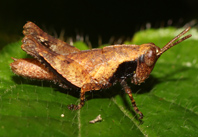Abstract
Four new Campylaimus species are described from the deep-sea sediments of the Sea of Japan at depths of about 500‒3400 m. Campylaimus orientalis sp. nov. is characterized by having a body of moderate length, clearly annulated cuticle, a small rhomboid mouth opening which is displaced on the dorsal side of body, a gap between the unequal limbs of the amphid, prominent narrow longitudinal alae and cephalated spicules. Campylaimus minutus sp. nov. is characterized by having a cylindrical body, very weak annulations, amphids with a short dorsal limb (25–44% of pharynx length) and a ventral limb completely fused with lateral alae of equal width; and lateral alae extending from the base of the amphid to the tail tip. Campylaimus amphidialis sp. nov. is characterized by having the combination of a very long amphidial fovea occupying nearly the entire length of the pharynx; and a well defined boundary between the ventral amphid limb and lateral alae. The distinctive feature of Campylaimus pulcher sp. nov. is the elongated loop-shaped amphid with nearly equal parallel limbs and prominent narrow longitudinal alae; and cephalated spicules without a gubernaculum. The diagnosis of the genus Campylaimus is emended and an identification key to species, based mainly on form and length of amphidial fovea, width of lateral alae, and copulatory apparatus is given. The genus Campylaimus now includes nineteen valid species. Two species are considered as species inquirendae, mainly because of incomplete descriptions.
References
Boucher, G. & Helléouët, M.N. (1977) Nématodes des sables fins infralittoraux de la Pierreoire (Mancheoccidentale). III. Araeolaimida et Monhysterida. Bulletin du Muséum National d´ Histoire Naturelle, 427, 85–122.
Bussau, C. (1993) Taxonomische und okologischeUntersu-chungen an Nematoden des Peru-Beckens. Ph.D. Thesis, University Kiel, Kiel, 621 pp.
Cobb, N.A. (1920) One hundred new nemas (type species of 100 genera). Contributions to a Science of Nematology (Baltimore), 9, 217–343.
Filipjev, I.N. (1918) Free-living marine nematodes of the Sevastopol area. Trudy Osoboi Zoologicheskoi Laboratorii Sevastopol'skoi Biologicheskoi Stantsii (Imperatorskoi) Akademii Nauk, 2, 1–350.
Fadeeva, N.P. & Mordukhovich, V.V. (2013) Free-living nematodes from the deep-sea of the Sea of Japan (Pacific), including the description of new and known species. Deep-sea Research II, 86–87, 119–123.
http://dx.doi.org/10.1016/j.dsr2.2012.07.044Filipjev, I.N. (1929) Les Nématodes libres de la baie de la Neva et de l'extrémitéorientale du Golfe de Finlande. Archiv für Hydrobiologie, 20, 637–699.
Gambi, C., Vanreusel, A. & Danovaro, R. (2003) Biodiversity of nematode assemblages from deep-sea sediments of the Atacama Slope and Trench (South Pacific Ocean). Deep-Sea Research I, 50, 103–117.
http://dx.doi.org/10.1016/S0967-0637(02)00143-7Gerlach, S.A. (1950) Die Diplopeltiden, eine Gruppe freileben der Nematoden. Kieler Meeresforsch, 7, 138–156.
Gerlach, S.A. (1956) Diagnosen neuer Nematodenaus der Kieler Bucht. Kieler Meeresforsch, 12, 85–109.
Huang, Y. & Zhang, N. (2006) Five new records of free-living marine nematodes in the Yellow Sea. Journal of Ocean University of China, 5, 29–34.
http://dx.doi.org/10.1007/BF02919369Miljutin, D.M., Gad, G., Miljutina, M.M., Mokievsky, V.O., Fonseca-Genovis, V. & Esteves, A.M. (2010) The state of knowledge on deep-sea nematode taxonomy: how many valid species are known down there? Marine Biodiversity, 40, 143–159.
http://dx.doi.org/10.1007/s12526-010-0041-4Sergeeva, N.G. (1981) New species of the genus Campylaimus (Nematoda, Araeolaimida) from the Black Sea and Sivash Lake. Zoologichesky Zhurnal, 60, 1717–1719.
Soetaert, K. & Heip, C. (1995) Nematode assemblage of deep-sea and shelf break sites in the North Atlantic and Mediterranean Sea. Marine Ecology Progress Series, 125, 171–183.
http://dx.doi.org/10.3354/meps125171Tchesunov, A.V. (1978) New nematodes of the order Araeolaimida from the Caspian Sea. Zoologichesky Zhurnal, 57, 19–25.
http://dx.doi.org/10.1134/S1063074011050117Tchesunov, A.V. (2006) Biology of marine nematodes. KMK Scientific Press Ltd, Moscow, 367 pp.
Tchesunov, A.V. & Miljutina, M.A. (2008) A new free-living nematode Intasia monohystera gen.n., sp. n. (Nematoda, Araeolaimida, Diplopeltidae) from the Barents Sea and the White Sea, with a key to genera of Diplopeltidae. Russian Journal of Nematology, 16, 33–48.
Thanh, N.V. & Gagarin, V.G. (2011) A new genus and two new species of marine free-living nematodes from the coastal waters of Southern Vietnam. Russian Journal of Marine Biology, 37, 66–370.
http://dx.doi.org/10.1134/S1063074011050117Thanh, N.V., Hien, N.T. & Gagarin, V.G. (2012) Two new nematode species of the family Diplopeltidae Filipjev, 1918 (Nematoda, Araeolaimida) from coast of Vietnam. Tap chísinhhoc, 34, 1–5.
http://dx.doi.org/10.15625/0866-7160/v34n1.663Timm, R.W. (1961) The marine nematodes of the Bay of Bengal. Proceedings of the Pakistan Academy of Sciences, 1, 1–84.
Villares, C, Martelli, A., Lo Russo, V. & Pastor, C. (2013) Three new species and one new record of Campylaimus (Diplopeltidae, Nematoda) from Argentine coasts (Buenos Aires and Santa Cruz, Argentina). Zootaxa, 3613 (1), 83–96.
http://dx.doi.org/10.11646/zootaxa.3613.1.4Vitiello, P. (1974) Considérationssur la systématique des Nématodes Araeolaimida et description d' espèces nouvelle soupeuconnus. Archives de Zoologie Experimentaleetgenerale, 115, 651–669.
Warwick, R.M., Platt, H.M. & Somerfield, P.J. (1998) Free-living Marine Nematodes. Part III. Monhysterids. Field Studies Council, Shrewsbury, 290 pp.
Zograf , J.K., Trebukhova, Yu.A. & Pavlyuk, O.N. (2015) New deep-sea free-living marine nematodes from the Sea of Japan: the genera Siphonolaimus and Halichoanolaimus (Nematoda:Chromadorea) with keys to species identifications. Zootaxa, 3911 (1), 63–80.
http://dx.doi.org/10.11646/zootaxa.3911.1.3

